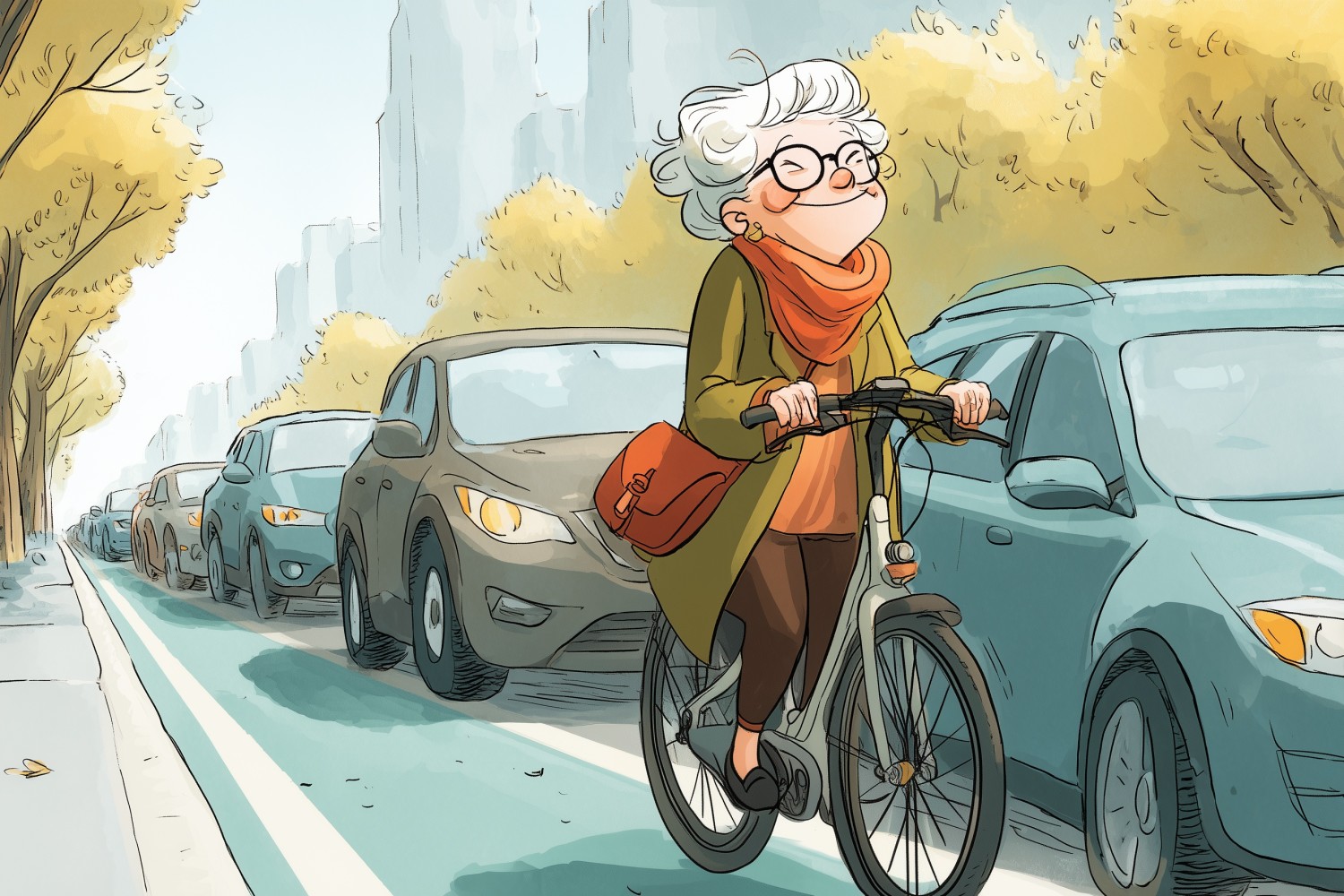
Last month, the City Council unanimously backed the next phase of the East Pico and Broadway Bicycle Safety Projects. These will bring quick-build, long-needed, and protected bike lanes to key stretches of both streets.
This is a good moment to re-post, edited and rewritten, an article we published in these pages three years ago, and which continues to be relevant today:
The Electric Steed Cometh
On a bright Saturday morning in Dana Point, the kind of coastal town that sells serenity by the square foot, a curious thing was happening. The streets, the sidewalks, the marina—everything was teeming with electric bicycles. Not just a few. Hundreds. A grandmother with a golden retriever in the front basket, a guy who looked like he ran a crypto startup weaving past an Escalade, a father and daughter combo riding in matching helmets. All of them cruising on two wheels, propelled as much by lithium-ion batteries as by pedaling.
This wasn’t just a weekend scene. It was a signal.
E-bikes are the thing before the thing. And like most “next big things,” they don’t shout. They whisper. You almost miss them—until you start counting.
According to the New York Times, sales of e-bikes in the U.S. rose 145% from 2019 to 2020. That wasn’t a blip. It was twice the growth rate of traditional bike sales in the same period. The trend didn’t slow down post-pandemic. Last year, Americans bought nearly 900,000 e-bikes. This year, we’re on pace to cross the million-unit threshold. To put that in perspective, that’s more than the number of electric cars sold in the U.S. during that same stretch.
But here’s the thing that would make any venture capitalist sit up straight: for a growing slice of Americans, e-bikes are not just recreational toys or pandemic hobbies. They’re transportation. Real, everyday, go-to-the-store transportation.
And yet, standing in the middle of Dana Point’s electric bicycle ecosystem, something else struck me.
Where were they in Santa Monica?
We’re the city of Big Blue Bus, of Metro Bikeshare, of the 15-Minute City dream. We’ve got protected bike lanes, a progressive planning commission, and a public image built partly on climate-forward mobility.
So why does it seem like Dana Point, a place known more for yacht clubs than urbanism, is miles ahead? Santa Monica, our so-called model city, the pearl of progressive planning, the smug kombucha stand at a chili cook-off, has somehow missed the moment. It’s not that electric bikes are entirely absent here. You’ll see them occasionally: a dad hauling kids to school, a teen riding to practice, the occasional Metro Bikeshare zipping by. But compared to Dana Point? It’s a whisper against a roar.
Let’s break it down.
There are four things you need to make e-bikes work as real transportation:
- Somewhere safe to store it at home.
- Somewhere safe to ride it.
- Somewhere secure to park it at your destination.
- A price point low enough to take the leap.
In the suburbs, people already have garages. They’re not dodging Uber drivers to cross the street. Their destination might be a park trail or a quiet cul-de-sac. The built-in infrastructure makes e-biking easier—even if it was never designed for it. Dana Point succeeds not through enlightenment, but through default. Wide suburban streets. Private garages. Calm traffic. It doesn’t try to be a biking city. It simply can be one.
Santa Monica tries. But try is not do. Try is politics. Try is grants and ribbons cut in front of half-finished projects. Try is a plan half-implemented and fading. Try locking an e-bike in the garage of a multifamily building, like mine, and you learn fast what a bolt cutter sounds like at 3 a.m. (Our building’s lost more than one bike to the underground garage bandits.)
Then there’s the street. Yes, we have protected lanes, some excellent, like the one on Colorado near Ocean, and others, well, not so much. Paint isn’t infrastructure. A confused driver in a crossover SUV doesn’t care if your bike lane has a green stripe or a “Yield to Bikes” sign. If the design is confusing, it’s dangerous.
Let’s call this what it is: an adoption bottleneck.
The people who could be riding are not. Not because they’re lazy. Not because they’re stubborn. But because they’re rational. They are not activists. They are not zealots. They are not interested in carbon footprints or Vision Zero or bike equity. They are interested in not getting hit by a Lexus while trying to get to Trader Joe’s. They are people with back pain. With kids. With groceries. With errands and dignity and too many things to do in too little time. This is the reality.
Reality is the man who won’t buy an e-bike because his apartment building has no safe place to store it. Reality is the woman who had her bike stolen from the “secured” garage three times. Reality is a mother who won’t ride with her child because the bike lane dissolves into traffic with the grace of a trap door.
E-bikes are different. They flatten hills. They shrink time. They make a 65-year-old with arthritis feel like a 30-year-old on a beach cruiser. In Norway, a study found e-bike riders traveled three times farther than they had on regular bikes, and replaced car trips in the process.
Here’s where it gets pungent: if you build a few really well-designed, truly protected lanes—just a few—the range and versatility of e-bikes means that riders will go out of their way to use them. E-bikes expand the radius of safety. One well-placed protected path can serve an entire neighborhood and more. The return on infrastructure investment can be huge.
But the final boss in the e-bike game is parking. Not just at home. At the destination.
You can’t lock a $1,500 e-bike outside a strip mall and walk away in good faith. Most stores don’t offer secure racks. The city’s valet bike parking at Farmers Markets and events? Gone. Some downtown office buildings prohibit bikes entirely, like mine. So even if someone wanted to commute on an e-bike, they’d have nowhere to stash it.
This is death by a thousand frictions. We were supposed to be ahead. But we are not. We are behind Orange County, and if that doesn’t sting you just a little, you’re not paying attention.
The State of California, in a rare moment of lucidity, is offering financial help to buy e-bikes. We in Santa Monica should take the offer and run, before our supposed bike culture becomes yet another performative gesture, another curious idea unridden. The electric steed has arrived. The only question is whether this city, in all its proud sophistication, will saddle up or sit it out.
Meanwhile, in Dana Point, someone’s grandma just passed a Tesla.
Daniel Jansenson, Architect
For SMa.r.t.
Santa Monica Architects for a Responsible Tomorrow
Daniel Jansenson, Architect (former Building & Fire-Life Safety Commissioner); Robert H. Taylor, Architect AIA; Thane Roberts, Architect; Mario Fonda-Bonardi, Architect AIA (former Planning Commissioner); Sam Tolkin, Architect (former Planning Commissioner); Michael Jolly AIRCRE; Jack Hillbrand, Architect AIA, Landmarks Commission Architect; Phil Brock (former Mayor); Matt Hoefler, Architect NCARB













